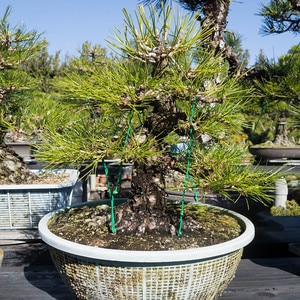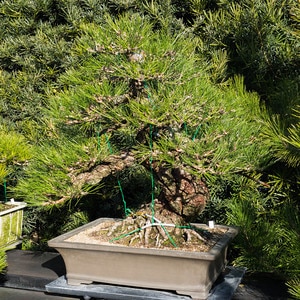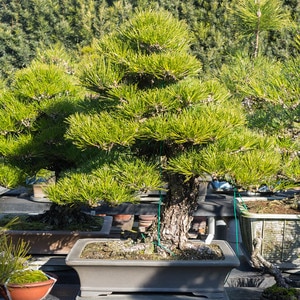My recent visit to Japan included a stop at the garden of one Mr. Iwakiri in Miyazaki, Kyushu. Iwakiri has been growing bonsai for more than 40 years and he has a wealth of knowledge on the topic, particularly when it comes to developing black pine.
As I mentioned a few weeks ago (see “A visit to Miyakonojou“) black pines developed by the seedling-cutting technique can often provide us with too much of a good thing. What to do when we find too many roots resulting from the seedling-cutting technique? Iwakiri has two recommendations:
- If developing anything but small bonsai, don’t use the technique. The seedling-cutting technique can result in overly homogenous roots. Eschewing the technique can allow for more natural looking roots.
- If developing small bonsai using the seedling-cutting technique, remove every other root. Keeping every root can yield more roots than makes sense for small trees and can create large flat root pancakes – a structure that doesn’t look natural for pines and one that makes fitting small trees into appropriately sized pots impossible.
Iwakiri has dutifully removed superfluous roots on his small pines for decades, but to really test the hypotheses, he kept all of the roots on a few trees as a control of sorts. Here’s what happened. At a glance, it appears that keeping all of the roots has produced a very nice root base. Upon greater scrutiny, we can see two problems. The more obvious is that the roots are all the same shape and size – a form rarely seen in nature. The bigger problem is that the root spread is quite large in relation to the base of the trunk. This second issue is more a matter of style and taste than the first, and for that reason I find it the more interesting of the two.
The ratio of trunk to root-base for the control tree is around 4:1. If the trees with larger trunks followed the same ratio, we’d have some humongous root bases. Would this be a problem? Does it depend on the tree? I’ve included photos below of the “control” tree along with some other bonsai from Iwakiri’s garden for comparison.

Black pine created via seedling-cutting

Root base detail – note how similar the roots are

Black pine – around 40 years old

Black pine – 30-40 years old

Black pine

Black pine
Subscribe to Indian Bonsai Art
New Posts Delivered Every Tuesday and Friday
